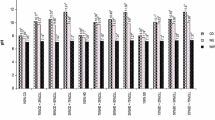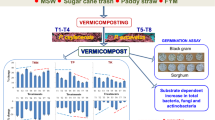Abstract
Present study aimed to evaluate the vermicomposting of lignocellulosic wastes employing Eisenia fetida earthworms. The study examined the effectiveness of vermicomposting for 105 days by mixing lignocellulosic waste (LW) with cattle manure (CM) in five different proportions. Results revealed that TOC and C/N ratio decreased gradually till end and in vermicomposts varied between 268–320 g/kg and 12.26–16.85, respectively. Nutrient content (NPK) in the vermicomposts increased with time in all the mixtures. Heavy metals’ content also increased in vermicomposts and benefit ratio for heavy metals ranged between 0.06 and 5.1. Increase in earthworm biomass (22.38–39.64 g) and reproduction (21.27–31.60 hatchlings/worm) was also satisfactory in all the waste mixtures. Based on results, it can be inferred that lignocellulosic waste can successfully be converted into good quality manure employing earthworms.







Similar content being viewed by others
References
Alidadi H, Hosseinzadeh A, Najafpoor AA, Esmaili H, Zanganeh J, Takabi MD, Piranloo FG (2016) Waste recycling by vermicomposting: Maturity and quality assessment via dehydrogenase enzyme activity, lignin, water soluble carbon, nitrogen, phosphorous and other indicators. J Environ Manag 182:134–140
Arumugam K, Renganathan S, Oluranti BO, Muthunarayanan V (2017) Investigation on paper cup waste degradation by bacterial consortium and Eudrillus eugeinea through vermicomposting. Waste Manag 74:185–193
Atiyeh RM, Edwards CA, Metzger JD, Lee S, Arancon NQ (2002) The influence of humic acids derived from earthworm processed organic wastes on plant growth. Bioresour Technol 84:7–14
Bhat SA, Singh J, Vig AP (2016) Effect on growth of earthworm and chemical parameters during vermicomposting of pressmud sludge mixed with cattle dung mixture. In: International Conference on Solid Waste Management, 5IconSWM 2015. Procedia Environ Sci 35:425–434
Bhattacharya SS, Kim KH (2016) Utilization of coal ash: is vermitechnology a sustainable avenue? Renew Sust Energ Rev 58:1376–1386
Brinton WF (2000) Compost quality standards and guidelines. Final report. Woods End Laboratories, Mount Vernon.
Buswell JA, Odier E (1995) Lignin biodegradation. Crit Rev Biotechnol 6:1–60
Chen Y, Chang SKC, Chen J, Zhang Q, Yu H (2018) Characterization of microbial community succession during vermicomposting of medicinal herbal residues. Bioresour Technol 249:542–549
Dominguez J (2004) State of the art and new perspectives on vermicomposting research. In: Edwards CA (ed) Earthworm ecology, 2nd edn. CRC, Boca Raton, pp 401–424
Edwards CA (1988) Breakdown of animal, vegetable and industrial organic wastes by earthworms. In: Edwards, C. A., Neuhauser, E.F. (eds) Earthworms in waste and environmental management. SPB Academic Publishing BV, The Hague 1988; pp. 21–31
Elvira C, Sampedro L, Benitez E, Nogales R (1998) Vermicomposting of sludges from paper mill and dairy industries with Eisenia andrei: a pilot-scale study. Bioresour Technol 63:205–211
Fernandez Gomez MJ, Romero E, Nogales R (2010) Feasibility of vermicomposting for vegetable greenhouse waste recycling. Bioresour Technol 101(24):9654–9660
Flack FM, Hartenstein R (1984) Growth of the earthworm Eisenia foetida on microorganisms and cellulose. Soil Biol Biochem 16(5):491–495
Garg VK, Yadav YK, Sheoran A, Chand S, Kausik P (2006) Livestock excreta management through vermicomposting using epigeic earthworm Eisenia fetida. Environmentalist 26:269–276
Gomez Brandon M, Lores M, Dominguez J (2013) Changes in chemical and microbiological properties of rabbit manure in a continuous-feeding vermicomposting system. Bioresour Technol 128:310–316
Hussain N, Singh A, Saha S, Kumar MVS, Bhattacharya P, Bhattacharya SS (2016) Excellent N-fixing and P-solubilizing traits in earthworm gut-isolated bacteria: a vermicompost based assessment with vegetable market waste and rice straw feed mixtures. Bioresour Technol 222:165–174
Lee KE (1992) Some trends opportunities in earthworm researcher Darwin’s children, the future of our discipline. Soil Biol Biochem 24:1765–1771
Malinska K, Zabochnicka Swiateka M, Caceresb R, Marfa O (2016) The effect of precomposted sewage sludge mixture amended with biochar on the growth and reproduction of Eisenia fetida during laboratory vermicomposting. Ecol Eng 90:35–41
Mitchell A (1997) Production of Eisenia fetida and vermicompost from feed-lot cattle manure. Soil Biol Biochem 29:763–766
Morais FMC, Queda CAC (2003) Study of storage influence on evolution of stability and maturity properties of MSW composts. In: Proceedings of the Fourth International Conference of ORBIT Association on Biological Processing of Organics: Advances for a Sustainable Society Part II. Perth, Australia.
Ndegwa PM, Thompson SA (2001) Integrating composting and vermicomposting in the treatment of bioconversion of biosolids. Bioresour Technol 76:107–112
Nelson DW, Sommers LE (1982) Total organic carbon and organic matter. In: Page AL, Miller RH, Keeney DR (eds) Method of soil analysis. American Society of Agronomy, Medison, 1982; pp 539–579
Parthasarathi K, Balamurugan M, Prashija KV, Jayanthi L, Basha SA (2016) Potential of Perionyx excavates (Perrier) in lignocellulosic solid waste management and quality vermifertilizer production for soil health. Int J Recycl Org Waste Agric 5:65–86
Pigatin LBF, Atoloye IO, Obikoya OA, Borsato AV, Rezende MOO (2016) Chemical study of vermicomposted agroindustrial wastes. International Int J Recycl Org Waste Agric 5:55–63
Pramanik P, Ghosh GK, Ghosal PK, Banik P (2007) Changes in organic C, N, P and K and enzyme activities in vermicompost of biodegradable organic wastes under liming and microbial inoculants. Bioresour Technol 98:2485–2494
Pramanik P, Safique S, Jahan A, Bahagat RM (2016) Effect of vermicomposting on treated hard stem leftover wastes from pruning of tea plantation: a novel approach. Ecol Eng 97:410–415
Reijnders L (2014) Phosphorus resources, their depletion and conservation, a review. Resour Conserv Recycl 93:32–49
Sahariah B, Goswami L, Kim KH, Bhattachatyya P, Bhattacharya SS (2015) Metal remediation and biodegradation potential of earthworm species on municipal solid waste a parallel analysis between Metaphire posthuma and Eisenia fetida. Bioresour Technol 180:230–236
Sharma K, Garg VK (2017a) Management of food and vegetable processing waste spiked with buffalo waste using earthworms (Eisenia fetida). Environ Sci Pollut Res 24(8):7829–7836
Sharma K, Garg VK (2017b) Vermimodificaion of ruminant excreta using Eisenia fetida. Environ Sci Pollut Res 24(24):199938–199945
Sharma K, Garg VK (2017c) Vermicomposting of lignocellulosic waste: a biotechnological tool for waste management. Phytoremediation of Environmental Pollutants, Taylor and Francis: 1:26.
Sharma K, Garg VK (2018) Comparative analysis of vermicompost quality produced from rice straw and paper waste employing earthworm Eisenia fetida (Sav.). Bioresour Technol 24(8):7829–7836
Song X, Liu M, Wu D, Qi L, Ye, Jiao J, Hu F (2014) Heavy metal and nutrient changes during vermicomposting animal manure spiked with mushroom residues. Waste Manage 34:1977–1983
Spiers GA, Gagnon D, Nason GE, Packee EC, Lousier JD (1986) Effects and importance of indigenous earthworms on decomposition and nutrient cycling in coastal forest ecosystems. Can J For Res 16:983–989
Suthar S (2008) Bioconversion of post harvest crop residues and cattle shed manure into value-added products using earthworm Eudrilus eugeniae Kinberg. Ecol Eng 32:206–214
Suthar S, Gairola S (2014) Nutrient recovery from urban forest leaf litter waste solids using Eisenia fetida. Ecol Eng 71:660–666
Swarnam TP, Velmurugan A, Pandey SK, Roy SD (2016) Enhancing nutrient recovery and compost maturity of coconut husk by vermicomposting technology. Bioresour Technol 207:76–84
Thomas GV, Mathew AE, Baby G, Mukundan MK (2018) Bioconversion of residue biomass from a tropical homestead agro-ecosystem to value added vermicompost by Eudrilus species of earthworm. Waste Biomass Valori. https://doi.org/10.1007/s12649-018-0203-3
Viel M, Sayag D, Peyre A, Andre L (1987) Optimization of in-vessel co-composting through heat recovery. Biol Wastes 20:167–185
Vig AP, Singh J, Wani SH, Dhaliwal SS (2011) Vermicomposting of tannery sludge mixed with cattle dung into valuable manure using earthworm Eisenia fetida (Savigny). Bioresour Technol 102:7941–7945
Yadav A, Garg VK (2010) Bioconversion of Food Industry Sludge into value-added product (vermicompost) using epigeic earthworm Eisenia fetida. World Rev Sci Technol Sust Dev 7(3):225–238
Yan YW, Azwady NAA, Shamsuddin ZH, Muskhazli M, Aziz SA, Teng SK (2013) Comparison of plant nutrient contents in vermicompost from selected plant residues. Afr J Biotechnol 12(17):2207–2214
Funding
One of the authors Kavita Sharma is thankful to the University Grants Commission, New Delhi (India), for providing financial assistance in the form of Post Doctoral Fellowship (Women Scientist).
Author information
Authors and Affiliations
Corresponding author
Additional information
Responsible editor: Philippe Garrigues
Publisher’s note
Springer Nature remains neutral with regard to jurisdictional claims in published maps and institutional affiliations.
Rights and permissions
About this article
Cite this article
Sharma, K., Garg, V.K. Recycling of lignocellulosic waste as vermicompost using earthworm Eisenia fetida. Environ Sci Pollut Res 26, 14024–14035 (2019). https://doi.org/10.1007/s11356-019-04639-8
Received:
Accepted:
Published:
Issue Date:
DOI: https://doi.org/10.1007/s11356-019-04639-8




